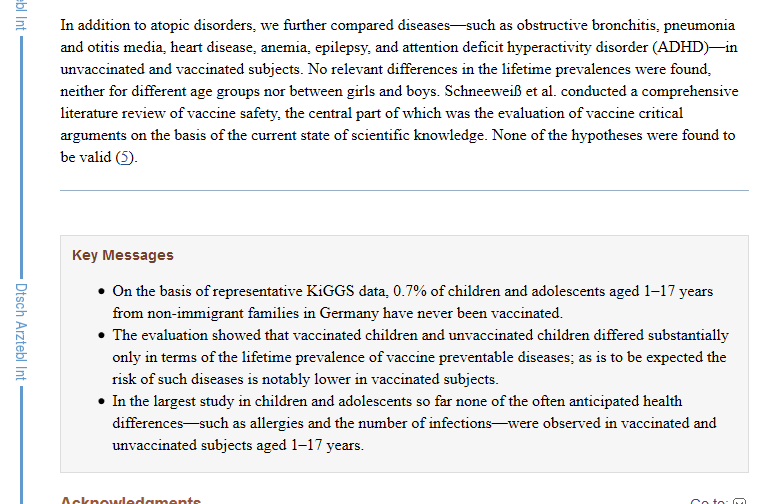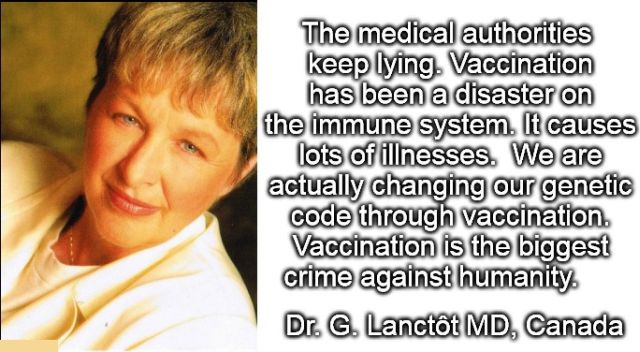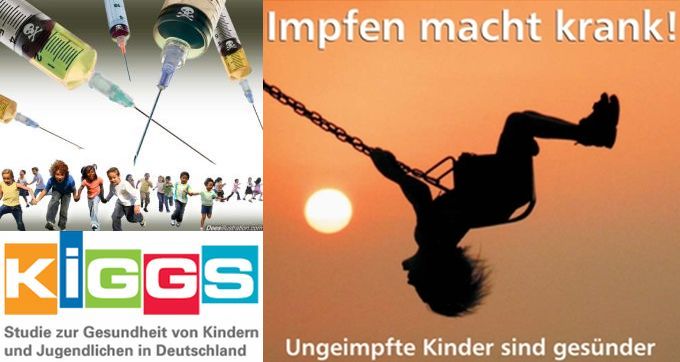German Study Confirms Vaccine-Free Children Healthier Than Vaccinated Children!
Impfen macht krank! – Vaccines promote ill-health! – Angelika Kögel-Schautz
15 July 2009
Translated from the original German webpage by Erwin Alber
Official study shows that vaccines make children sick!
Do You Want to Remain Informed about the Latest Vaccine News?
Vaccinated children and youths have considerably more allergies, suffer more often from developmental disorders such as hyperactivity and have a lot more infections and more chronic illnesses. Responsible parents inform themselves and don’t get their children vaccinated!

From May 2003 until May 2006, Germany’s highest health authority, the Robert-Koch-Institut (RKI), conducted a large study referred to as the KiGGS study (KiGGS is a made-up word denoting a health study of children and youths) to study the physical and mental health of nearly 18,000 children and youths between the ages of 0 and 17 years. At the start, the children and their parents were asked to complete a comprehensive questionnaire. The second part comprised an interview with a doctor as well as blood and urine tests. Where available, the vaccination documents were also copied. At the end, there were about 1,500 bits of data for each of the nearly 18,000 participants.

Already during the course of the study, the importance of this undertaking was repeatedly stressed. Examination of the study data was going to provide comprehensive insight concerning the health of today’s children and youths and the various factors influencing it. This would provide a basis to further improve the health of children and youths – the issue of vaccinations was also going to be addressed!
One year after the end of the study, its results were already presented to the public on 400 pages of a double issue of the Federal Health Bulletin. As expected, the data concerning vaccination had not been evaluated with the other health values of children and youths. Those of us who know our health authorities are in any case sick of hearing (as a substitute for dealing with the subject in a serious and scientific manner) of the usual mantra of “Vaccinations are one of the most important medical inventions..blablabla.” It would therefore have amounted to a miracle if even a hint of doubt concerning the benefits of vaccination had been published.
An offer was however made to make the raw data of the study available to interested members of the public as a so-called „Public Use File.“ I was therefore very pleased to be able to order a set of the raw data at the beginning of this year for a fee of 90.00 Euro. I feared to the very last that my request would be denied, as I had openly declared on the order form what I intended to do with the data.
Those who know me are aware that as someone trained in mathematics and Information Technology, I love numbers and logic as well as difficult challenges relating to these topics. At first, it however seemed impossible to make any progress. The accompanying description of the data was inconsistent, contradictory, incomplete, not following a logical train of thought and insufficiently detailed. In this study as well, in order to skew the results, one had once again
tried to throw children who were unvaccinated or had been given few vaccines because they were either neglected or too sickly into the same group as the very healthy children of parents who had made an informed decision to keep their children vaccine-free, or to selectively vaccinate, e.g. only against tetanus, but refusing other vaccinations.
Even though I had anticipated this, it turned out that after a few days of deliberating I was somewhat at a loss of how to proceed as too many important answers in response to vaccine-related questions has been removed from the raw data after the study had ended. The answers from two pages of doctor interviews were completely missing (see graphic 1 below). Here were e.g. the questions: “What reasons did you have for not getting your child vaccinated?” or “Has your child had an adverse reaction to a vaccine?”
Graphic 1: Some questions from the KiGGS study questionnaire concerning the subject of vaccination, the answers to which were not included in the set of data made available to the public.

———-
Translation:
4. Did you have reasons for not getting your child vaccinated? 1. Yes 2. No 3. Don’t know
5. What reasons did you have for not getting your child vaccinated?
1. Was your child often sick?
2. Are you concerned about vaccine side-effects?
3. Do you consider it better for your child to get some infectious diseases than to get the corresponding
vaccinations?
6. Has your doctor advised you against vaccinations for your child? 1. Yes 2. No 3. Don’t know
Which vaccines has your doctor advised you against?
1. Reason
2. Reason
3. Reason
7. Has your child had an adverse reaction?
Only relate serious adverse events, e.g. fever cramps, swelling of an entire limb, generalurticaria (hives all
over the body), inconsolable crying.
1. Vaccination
What were he symptoms?
Which vaccination?
How many days after the vaccination died the symptoms appear? _ _ days
Was a vaccine injury officially accepted? Yes…. No….
———-
Answers to these questions would have made it possible to differentiate between children whose parents had made a conscious decision to give few or no vaccines and children who were unvaccinated or only partially vaccinated because their parents had neglected to concern themselves with the vaccination issue. The distinction would have been important because the inclusion of children who had been given few or no vaccines because they were sickly has a negative effect on the statistics of children in radiant health because their parents have made an informed choice not to vaccinate them.
When sitting somewhat apprehensively in front of the huge KiGGS data sheet on the third day of my self=prescribed “occupational therapy”, I suddenly discovered data concerning the total number of vaccinations. For each vaccination was indicated whether the study participant had been vaccinated according to the recommended vaccination schedule or not. The number of vaccine doses was also listed. This provided the first signs indicating that this comprehensive study could provide important information concerning the better health of unvaccinated children and youths, e.g. in regard to
Allergies.
Everyone who knows an allergy sufferer or is afflicted by allergies is aware hw much this chronic illness reduces the quality of life. Allergies have been known to be vaccine-related adverse reactions for some decades. An experienced homeopathic doctor told me at the 1. Impfkritiker Konferenz I organised in 1997 that hay fever was only described since the smallpox vaccine was first used.
Further historic investigations also showed that wherever vaccinations were carried out, allergies would break out like an epidemic shortly after. In recent times, vaccine advocates and health authorities have however been increasingly making the absurd claim that vaccinations protect against allergies! They are fond of pointing out that in East Germany where vaccination had been compulsory, allergies were quite rare. I however know from reliable sources that in the DDR allergic children were given few or no vaccines because their caregivers were aware of the connection!
I therefore combed through the KiGGS data with great anticipation to find confirmation for some of these things and wonderful evidence was indeed forthcoming: in the age group of vaccinated 10 – 17-year-olds, 14.2 % had eczema, 16.2 % had hay fever and 12 % a contact allergy known as chrome allergy. Of the completely unvaccinated children in this age group 7.3 % had eczema, 9 % hay fever and 1.8 % a chrome allergy.
Graphic 2: Link between allergies and vaccinations

In simple terms this means that the incidence of eczema is double, the incidence of hay fever nearly double, and chrome allergy 6 times more common in vaccinated children compared to unvaccinated children.
If one had been able to filter out the children who had been given few or no vaccinations because they were too sick from the group of unvaccinated children, the difference would be even greater. It is also regrettable that this group of children for which information concerning vaccination is completely missing is with 7 % rather large. One has to assume that many children whose parents made an informed choice to give them few or no vaccines are hiding in this group. It seems that in order to avoid uncomfortable arguments with the doctors conducting the study, the parents refused to answer the questions related to vaccinations. This attitude of parents is understandable as the doctors conducting the study were likely to have been instructed to put pressure on parents to consent to any outstanding vaccinations there and then. Parents of unvaccinated children are after all well-acquainted with scaremongering tactics and psychological pressure. My research will provide parents with a powerful counter-argument! Because these were personal interviews, it would have been easy to reduce the rate of missing answers. Vaccinations were however only a subordinate aspect of the study so that the motivation of those conducting the study would have been correspondingly low in this regard. It is quite possible that even completely unvaccinated children were put in the group of children without vaccination documents, much like what happens at school medical exams time.
Social level and vaccination rates
A further surprise were the vaccination rates in accordance with social strata. This was explored in regard to 9 different vaccines: tetanus, diphtheria, polio, HIB (bacterial meningitis), pertussis (whooping cough), Hepatitis B (now usually administered as a sextuple vaccine) – as well as the vaccine against measles, mumps and rubella (MMR), sometimes with the varicella (chickenpox) vaccine added (MMRV).
Graphic 3: Vaccination rates in accordance with vaccine and social strata

The differences in the vaccination rates show clearly that the parents deliberately choose from a variety of options ranging from completely vaccinated to completely unvaccinated. This is however becoming increasingly difficult for parents because as many or most vaccinations are now available only in combination injections, which means that parents are being forced to either fully vaccinate their child, or refuse all vaccines.
This evidence, of parents making a deliberate decision concerning vaccination, is an important argument against the common accusation that non-vaccinating parents are guilty of “child neglect”, of “irresponsibility” or of “Impfmüdigkeit” (“vaccination fatigue”). The right to bring up and care for our children is after all enshrined in our constitution. We need to renew our claim to this right because we now have powerful arguments in our support!
No vaccination, no risk
I choose tetanus as an example to illustrate this provocative statement. On the one hand, tetanus can be very serious, which is why many people fear this disease most. On the other hand, there can be no “herd immunity” in regard to tetanus – meaning that with tetanus the unvaccinated are not “protected by the vaccinate majority,” because tetanus infection does not spread from one person to another. The issue of disease protection is another inexhaustible subject which I will write about in detail in my book “Die Masern-Intrige“ (“The Measles Intrigue”).
Of the 17,641 study participants, 217 were not vaccinated against tetanus = 1,3 %.
If – based on this figure – one calculates the number of children and youths in Germany who have have not been vaccinated against tetanus, one arrives at a figure of far in excess of of 100,000 children and youths between the ages of 1 and 17 years. Regardless of this, there has not been a single tetanus-related death for several decades in Germany. The few children (between 0 and 4 children per year) who according to hospital statistics get tetanus are successfully treated. Their vaccination status (vaccinated or unvaccinated) is not made available. Certainly, there would therefore have been vaccinated children among them.
On average, 23 vaccines!
There were 1,779 children and youths aged 10 – 17 years in the KiGGS study who had received more than 30 vaccines in their lives, mostly by way of combination injections. On average, they had received nearly 23 vaccines! I find this horrendous, considering the ingredients such as mercury, aluminium and antibiotica in vaccines.
Vaccinations and impairment of brain development
Impairment of brain development is a further important aspect in regard to the health of children and youths. Here too there have been competent critics of vaccinations who see many links between all manner of mild and severe brain disorders and vaccinations and warn that vaccines permanently impair the maturation of the brain during the very important first few months and years of a child’s life.
The incidence of Attention Deficit Disorder with or without Hyperactive Disorder (ADD, ADHD) is increasing among our children and youths and is often treated with prescription drugs such as Ritalin. So-called learning difficulties and developmental disorders are also diagnosed with increasing frequency and “treated” with a variety of drugs and therapies.
Graphic 4: Disordered brain development and vaccines

Here also, it is all the more important to find confirmation from the analysis of the study data that early and frequent vaccinations impairs normal brain development. Vaccinations are started earlier and earlier. In Germany, a baby who is vaccinated according to the official recommendations receives its first lot of shots (six-vaccines-in-one-injection combination vaccine) at the tender age of 8 weeks – while in the USA babies are even vaccinated the day after they are born and then again at 6 weeks!
Many of these babies start screaming at high pitch and cry inconsolably for hours due to the hellish torture and unbearable pain they are being put through when they are injected and their brain membranes become inflamed and their brains swell. This shrill, piercing screaming is a known adverse effect of vaccination and is listed as an possible adverse on some of the vaccine package inserts. It is referred to as “cri encephalique” (brain-related scream) in the medical literature. In the vaccine licensing studies babies who scream in this manner the first or the second time they are vaccinated are commonly removed from the study so as not to endanger the vaccine’s safety profile. Some mothers whose children were severely damaged vaccines relate that they noticed this type of screaming lasting several hours in their babies after the first vaccination.
Because this type of screaming is so common after vaccination, it often happens that the pediatrician who is informed about about a baby’s screaming dismisses it as “normal” and tells the mother off for being hysterical and continues to vaccinate. This is medical malpractice of the worst kind! Vaccine package inserts advise to discontinue vaccinations if a reaction occurs. If the doctor continues to vaccinate, the child is at risk of epileptic fits and severe brain damage after the second or third vaccination.

Dr. Buchwald, Germany’s oldest vaccine critic, mentions in his lectures that vaccines often cause an impairment of the optic nerves. Optic nerve damage is even mentioned as a vaccine reaction on a vaccine package insert of one of the childhood vaccines. It is therefore not surprising that unvaccinated children are less likely to need and wear glasses than vaccinated children.
It is also a relatively common for vaccine recipients to suddenly become blind, yet no other possible cause other than the vaccination can be found in such instances.
On average, of the children and youths aged 5 – 17 years, 9.1 % of vaccinated children suffer from ADHD, compared to 8.4 % of the unvaccinated. If the parents commented that their child was very fidgety and unable to pay attention, this was deemed a case of “suspected ADHD” for the purpose of the study. Of the vaccinated children, 3.3 % were deemed to suffer from suspected ADHD, while the figure for vaccine-free children was 1.8 %.
Of the vaccinated children, 4.6 % required speech therapy, but only 2.4 % of the vaccine-free children.
Of the vaccinated children, 20.8 % needed glasses, of the unvaccinated children, 18.1 %.
Of the vaccinated children, 2 % suffered from epilepsy (brain-related convulsions); none of the unvaccinated children suffered from epilepsy.
Susceptibility to infections
If – as we have seen – vaccinated children are more likely to suffer from allergies and abnormal brain development, are they thanks to the vaccinations they have had at least less susceptible to infectious diseases and therefore healthier? The study results show that the opposite is the case: vaccination increases susceptibility to infections, such as infections of the stomach or the intestinal tract, or common colds. Children aged 1 – 17 years who had no infections of any kind over the past year had on average had 21.2 vaccines; children who had between 1 and 10 infections had been given a total of 24.4 vaccines and children with over 30 (!) infections had on average been given 25.8 vaccines in total. (In the USA, the country with the most officially recommended vaccines, a child will have had 70 vaccines by the age of 18 if the recommendations are followed).
Because the study data not only featured the information whether a child has been given a certain vaccine, but also the exact number of vaccines it had been given, it was possible to determine a possible link between the number of vaccine doses a child had been given and the average number of infections a child had contracted over the past year.
Graphic 5: Average number of infections over the past year taking into consideration the number of vaccines the child had.

The more vaccinations children had, the more they were susceptible to infections. (This may from the pharmaceutical industry’s point of view be quite a desirable outcome as this creates further profits from the sale of drugs to treat infections).
Serious illnesses
Children who have had many vaccination are not only more likely to suffer from acute infections, but also from chronic illnesses: only 6 % of unvaccinated children aged 13 – 17 years suffer from chronic illness, but 14.8% of vaccinated children – more than double the number of unvaccinated children – are chronically ill.
Graphic 6: Link between vaccinations and serious illness

Vaccinated children are also more likely to suffer from serious infections such as pneumonia and inflammation of the inner ear than unvaccinated children. Of the vaccinated children, 11 % had suffered from pneumonia; of the unvaccinated children 9 %. Of the vaccinated children, 50 % had suffered from inner ear inflammation; of the unvaccinated, 37 %.
Parents and natural health practitioners who have been paying attention to these things have known about these connections for decades. It is therefore not surprising that the more children there are in a family, the less likely it is that the younger children will be vaccinated. The negative experiences with vaccines result in parents not vaccinating the children who are born later. Depending on the age group, unvaccinated children have up to a third more siblings than vaccinated children.
Educational level of parents
Unfortunately the medical tactic of using specialist language to manipulate unwary parents into allowing their children to be vaccinated is very effective. The more educated mothers are, the less likely they are to fall victim to this as well-educated mothers find it easier to deal with the vaccination-related issues. The more educated a mother, the less likely it is that her children will be vaccinated. I of course do not consider mothers with lesser educational levels less responsible; I do regret that there is not nearly enough generally understandable information critical of vaccination which is available for everyone.
Fathers’ educational levels seems to play a much more subordinate role in regard to the vaccination decision. This is also confirmed by the fact that only a small fraction of those who attended the over 100 lectures I gave over the past 14 years were fathers. It is my heartfelt wish that both parents take on the responsibility of the vaccination decision and that in the future, more fathers become involved in this important issue.
As I have mentioned earlier, the study data made available had unfortunately to some extent been sanitised. Some of the answers and findings were missing. As I have also pointed out, important questions regarding vaccination concerning adverse events and reasons for not vaccinating were missing as well. Furthermore, the part of the study dealing more intensively with psychological disorders was likewise absent. I will of course try to obtain the missing pieces in order to complete this analysis and have already requested the missing information from the Robert-Koch-Institut. I however consider it unwise to invest much energy, time and money in this regard as the results are already clear enough and one would have to obbtain permission from the health authority before publishing the results.
I am nevertheless very grateful that the raw data was finally also made available to us. I have also not given up on the hope to establish a real dialogue with advocates of vaccination who work for the health authorities. I have it from a reliable source that well-founded arguments and publications by serious vaccine critics are read in those places.
Conclusion
The conclusion of my analysis of this impressive study is that unvaccinated children are in every respect healthier than vaccinated children as regards both their physical as well as their psychological health.
The current practice of defaming unvaccinated children and their parents must therefore be stopped immediately, along with the direct and indirect pressure to vaccinate, as e.g. the exclusion of unvaccinated children from school.
Responsible and informed parents don’t get their children vaccinated.
In this article, I have briefly described the benefits to the individual in the form of better health resulting from not vaccinating. I will describe in detail the benefits for the public by not vaccinating, using the example of measles, in my book “Die Masern-Intrige“ (The Measles Intrigue).
Unvaccinated children are also a blessing to society because they uphold the natural and necessary processes resulting from infectious childhood diseases. When in the future mothers would again be allowed to catch measles, measles would e.g. no longer occur in babies, when the disease can have very serious consequences.
Source of data:
Public-Use-File KiGGS, Kinder und -Jugendgesundheitssurvey 2003-2006, Robert Koch-Institut, Berlin 2008.

Angelika Kögel-Schauz
I have been actively involved in informing the public about vaccination for more than 20 years now. It all started when one of my four children got encephalitis after receiving the Diphtheria-Tetanus vaccine. This prompted me to research the issue and I have continued steadily to this day. My greatest wish is for vaccination to be questioned scientifically. As such, in 1997 I organised the very first conference on vaccination in Germany. At the second conference in 1999, there were already some 600 participants. This led to the organisation of many further conferences and also self-help groups for young parents and other interested parties. I have given around 100 lectures and written innumerable articles.
My background is in IT but I now only work part-time in this field. My second profession, or better still, my vocation, remains vaccination information. Every free hour of my day is devoted to this pursuit. During the global economic crisis in 2008, I was forced to stay at home so I used the time to evaluate the results of a very large study on the health of the entire German population, commissioned by the German government. My objective was to compare the health status of vaccinated vs. that of unvaccinated children and youths (KIGGS study). The results of this comparative study revealed that vaccination has an enormous negative impact on our children’s health.
I have been the leader of a vaccine risk awareness group for young Bavarian parents and have also been the owner and moderator of a website and several Facebook pages, all efficient ways to spread information. My work is almost exclusively voluntary but the members of my large family do help a lot and have done so for many years.
My three eldest children are now grown-up. This allows me to devote more time and energy to my two main projects: a book and the expansion of my website. It is my dream for all parents to have freedom of informed choice, based on full and unbiased information, whether they choose to vaccinate their children or not.
———————————————
A comment:
In February 2011, the German medical journal “Deutsches Ärzteblatt” published an article with the following title:

According to this article there was basically no difference between the health of vaccinated and unvaccinated children who participated in the KiGGS study except that vaccinated children had a lesser incidence of vaccine-preventable diseases. In view of Angelika’s findings, I find this conclusion somewhat credibility-stretching! Here is the relevant part:

So “Schneeweiß et al. conducted a comprehensive literature review of vaccine safety, the central part of which was the evaluation of vaccine critical arguments on the basis of the current state of scientific knowledge. None of the hypotheses were found to be valid.”
I suspect a “snowjob.” I find it interesting to note that the investigator’s name “Schneeweiss” means “Snowwhite” in English.
My suspicion is further underpinned by this statement by Canadian Dr. G. Lanctôt MD:

Erwin Alber

